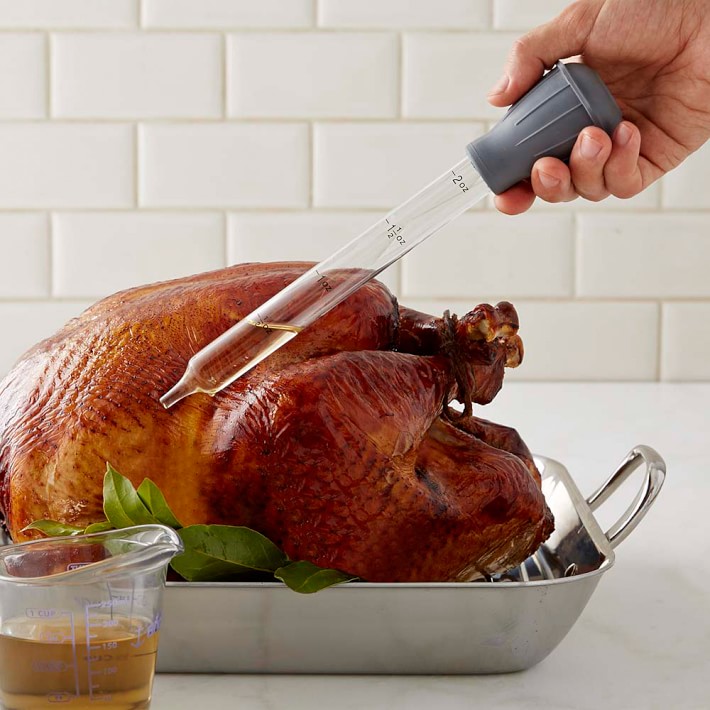The turkey baster, a seemingly humble kitchen tool, often takes center stage during Thanksgiving, as its primary role is to help achieve that perfectly succulent and flavorful turkey. However, beyond its seasonal spotlight, the turkey baster proves to be a versatile and handy utensil with a range of applications in the kitchen. In this article, we will explore the history, design, and various uses of the turkey baster, showcasing its importance beyond the holiday season.
The Evolution of the Turkey Baster
The turkey baster has come a long way from its early, simple designs. Originally, it was a basic tube with a rubber bulb at one end, primarily used to collect pan juices and baste the turkey during roasting. Over time, the design has evolved, incorporating new materials and features to enhance its functionality.
The first patent for a basting syringe, the precursor to the modern turkey baster, was filed in the late 19th century. Early designs were made from glass and lacked the convenience of today’s squeezable bulb. As technology advanced, materials like plastic and silicone became prevalent, making the baster more durable, heat-resistant, and easy to clean.
Design Features of Modern Turkey Basters
Today’s turkey basters are designed with both functionality and user convenience in mind. The typical components include a squeezable bulb, a tube, and a heat-resistant tip. Let’s explore these design features in detail:
Squeezable Bulb: The bulb, usually made from silicone or rubber, provides a comfortable grip and allows for easy control of the basting process. Its flexibility enables the user to release the desired amount of liquid evenly over the food.
Tube: The tube is often made from heat-resistant materials like silicone or plastic. Its length is designed to reach the bottom of a roasting pan or baking dish, ensuring efficient collection and distribution of liquids.
Heat-Resistant Tip: The tip of the baster is a crucial element, as it comes into direct contact with hot liquids. Heat-resistant materials ensure that the tip can withstand high temperatures without melting or warping.
Easy-to-Clean Design: Many modern turkey basters are designed for easy disassembly, allowing for thorough cleaning. This is particularly important, as accumulated fats and juices can lead to bacterial growth if not cleaned properly.
The Culinary Uses of Turkey Basters
While the turkey baster is an indispensable tool for roasting poultry, its utility extends far beyond Thanksgiving. Here are several creative ways to make the most of your turkey baster in the kitchen.
Basting Various Roasts: Beyond turkey, a baster can be used to enhance the flavor and moisture of other roasts, such as chicken, beef, or lamb. Regularly basting during the cooking process helps prevent dryness and imparts delicious flavors to the meat.
Marinade Injector: The narrow tip of the turkey baster makes it an excellent tool for injecting marinades into meats. This method ensures that the flavors penetrate deep into the meat, resulting in a more flavorful dish.
Collecting Pan Juices: Use the turkey baster to collect pan juices from roasted meats. These juices can be used to make rich gravies, sauces, or to moisten the meat when serving.
Flavoring Vegetables: Utilize the baster to distribute flavorful liquids, such as herb-infused oils or broths, over vegetables while roasting. This enhances the taste and helps vegetables caramelize beautifully.
Custard Filling for Baking: When preparing delicate desserts like custards, the turkey baster can serve as a precise tool for filling individual molds, ensuring an even distribution of the mixture.
Pancake and Waffle Batter Dispenser: For breakfast enthusiasts, a turkey baster can be repurposed as a batter dispenser. Its controlled release makes it easy to create perfectly round pancakes or evenly sized waffles.
Removing Excess Grease: After cooking ground meats, use the baster to remove excess grease from the pan, promoting a healthier dish without compromising flavor.
Conclusion
The turkey baster, once reserved for Thanksgiving Day, has proven to be an invaluable kitchen tool with diverse applications. Its evolution from a simple glass tube to a modern, heat-resistant utensil reflects the adaptability of kitchen gadgets over time. Whether basting roasts, injecting marinades, or creatively dispensing pancake batter, the turkey baster has secured its place as a versatile and indispensable kitchen companion. So, the next time you reach for this seemingly humble tool, consider the myriad ways it can elevate your culinary adventures beyond the holiday season.







